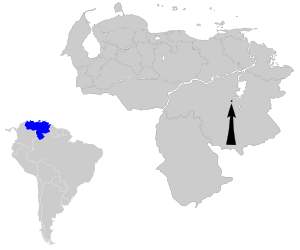Guaiquinima whitestart facts for kids
Quick facts for kids Guaiquinima whitestart |
|
|---|---|
| Conservation status | |
| Scientific classification | |
| Genus: |
Myioborus
|
| Species: |
cardonai
|
 |
|
The Guaiquinima whitestart (Myioborus cardonai) is a small, colorful bird. It is also known as the Guaiquinima redstart. Other names include the saffron-breasted whitestart or saffron-breasted redstart. This bird belongs to the Parulidae family, which includes many types of warblers.
This special bird lives only in one specific place. It is found in humid highland forests. These forests are located on Cerro Guaiquinima in south-eastern Venezuela. Sadly, the Guaiquinima whitestart is currently threatened. Its home is slowly disappearing due to habitat loss.
Contents
About the Guaiquinima Whitestart
The Guaiquinima whitestart was first described in 1945. It was named by two scientists, John Todd Zimmer and William Henry Phelps. The bird gets its name from Cerro Guaiquinima. This is the mountain where it lives.
What It Looks Like
Whitestarts are known for their bright colors. They often have white patches on their tails. These patches flash when the bird flies. This can make them easy to spot. The saffron-breasted whitestart has a distinctive saffron, or orange-yellow, chest. This is how it gets one of its common names.
Where It Lives
This bird is endemic to a very specific area. This means it lives nowhere else in the world. Its home is the humid highland forests of Cerro Guaiquinima. This mountain is located in the south-eastern part of Venezuela. These forests are often misty and wet. They provide the perfect home for this unique bird.
Why It's Important
Every animal plays a role in its ecosystem. The Guaiquinima whitestart is part of the natural balance in its forest home. It helps control insect populations. It also helps spread seeds as it moves around. Protecting this bird means protecting its forest.
Facing Challenges
The biggest threat to the Guaiquinima whitestart is habitat loss. This happens when the forests where it lives are cut down or changed. When its home disappears, the bird has nowhere to live. This makes it harder for them to find food and raise their young. Conservation efforts are important to protect this species.
See also
 In Spanish: Candelita de Cardona para niños
In Spanish: Candelita de Cardona para niños


